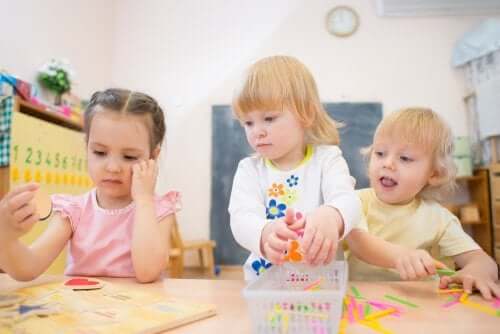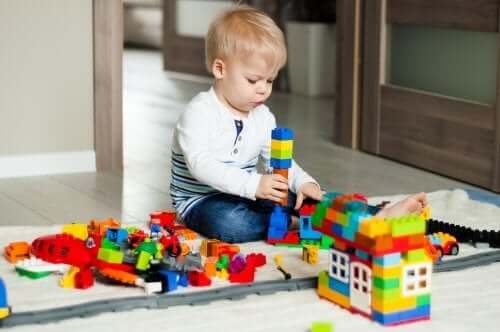The Development of Attention in Children


Written and verified by the psychologist Ana Couñago
The ability to pay attention is a fundamental ability when it comes to cognitive processing. Acquiring this ability is important in order to carry out further learning in a normal way. For this reason, we’ve put together the following article about the development of attention in children.
Therefore, we can consider attention to be a complex mental process that is fundamental to a child’s correct functioning. Furthermore, this ability determines the conduct of little ones. In fact, difficulties when it comes to attention comes with the appearance of a variety of problems, both during infancy as well as in adulthood.
The importance of developing attention in children
According to psychologists Jose A. Perianez Morales and Marcos Rios Lago, attention is defined as the mental ability to produce and maintain a state of activation that allows for the processing of information that arrives through the senses.
In this sense, attention is necessary in order to distinguish and select stimuli among multiple available sources. These include:
- Internal stimuli: Physical sensations, mental processes, etc.
- External stimuli: Sounds, images, etc.
- Memory.
- Thoughts.
- Motor actions.

Therefore, attention consists of filtering undesired information and concentrating solely on what’s really relevant. So, in order to carry out any cognitive process, attention mechanisms need to go to work. In other words, a certain level of selection between all of the stimuli that reaches the nervous system is fundamental.
In short, we can say that it’s a complex process with two functions:
- Facilitating the processing of information.
- Selecting the stimuli necessary for carrying out different sensory, cognitive or motor activities.
Types of attention
According to Sohlberg and Mateer’s clinical model of attention, there are six types of attention. They arranged these types in the form of a hierarchy, given that each attention level requires the correct function of the previous one.
Therefore, the development of attention in children takes place gradually. Little by little, children acquire each one of the following attention levels:
- Arousal. This refers to physiological activation. In other words, it’s the ability to be awake and remain alert. It applies the ability to follow stimuli and orders.
- Focus attention. This is the capacity to focus attention on visual, auditory or tactile stimuli.
- Sustained attention. This refers to the ability to maintain concentration during a long period of time.
- Selective attention. This is the capacity to select relevant information, meaning an individual can ignore some stimuli while paying attention to others.
- Alternating attention. This is the ability that allows an individual to switch his or her focus between different tasks that apply different cognitive processes.
- Divided attention. At this level, a person can tend to two tasks at the same time.
Development of attention in children
The first months of life
The development of attention in children appears from the first months of life and continues to progress through their maturative development. Therefore, babies manage to concentrate on the tasks they find attractive. But, they lose interest easily and quickly.
As a result, they only tend to task for a few seconds or minutes. In fact, they don’t yet have the capacity to analyze situations or control their attention.
The infancy stage
During the stage of infancy, children develop voluntary attention. Over this period, children learn to control their attention and stay concentrated for longer periods of time.

However, infants and toddlers still become distracted by new or attractive images. Therefore, they’re unable to remain focused on the same activity for more than 20 minutes.
5 years and up
From the age of 5 onwards, children learn when and how to pay attention. Therefore, concentration becomes more stable.
During this developmental stage, children also acquire the ability to analyze a situation. They also decide to pay more or less attention depending on their interest in the activity or topic.
Internal processes play a very important role. They’re what directs a child’s attention and allows him or her to remain concentrated for a maximum of 50 minutes.
“Cultivate attention, you will have good attention. A serene mind is fit for concentration. Keep the mind serene. Be cheerful always. Then alone you can concentrate.”
– Swami Sivananda –
The ability to pay attention is a fundamental ability when it comes to cognitive processing. Acquiring this ability is important in order to carry out further learning in a normal way. For this reason, we’ve put together the following article about the development of attention in children.
Therefore, we can consider attention to be a complex mental process that is fundamental to a child’s correct functioning. Furthermore, this ability determines the conduct of little ones. In fact, difficulties when it comes to attention comes with the appearance of a variety of problems, both during infancy as well as in adulthood.
The importance of developing attention in children
According to psychologists Jose A. Perianez Morales and Marcos Rios Lago, attention is defined as the mental ability to produce and maintain a state of activation that allows for the processing of information that arrives through the senses.
In this sense, attention is necessary in order to distinguish and select stimuli among multiple available sources. These include:
- Internal stimuli: Physical sensations, mental processes, etc.
- External stimuli: Sounds, images, etc.
- Memory.
- Thoughts.
- Motor actions.

Therefore, attention consists of filtering undesired information and concentrating solely on what’s really relevant. So, in order to carry out any cognitive process, attention mechanisms need to go to work. In other words, a certain level of selection between all of the stimuli that reaches the nervous system is fundamental.
In short, we can say that it’s a complex process with two functions:
- Facilitating the processing of information.
- Selecting the stimuli necessary for carrying out different sensory, cognitive or motor activities.
Types of attention
According to Sohlberg and Mateer’s clinical model of attention, there are six types of attention. They arranged these types in the form of a hierarchy, given that each attention level requires the correct function of the previous one.
Therefore, the development of attention in children takes place gradually. Little by little, children acquire each one of the following attention levels:
- Arousal. This refers to physiological activation. In other words, it’s the ability to be awake and remain alert. It applies the ability to follow stimuli and orders.
- Focus attention. This is the capacity to focus attention on visual, auditory or tactile stimuli.
- Sustained attention. This refers to the ability to maintain concentration during a long period of time.
- Selective attention. This is the capacity to select relevant information, meaning an individual can ignore some stimuli while paying attention to others.
- Alternating attention. This is the ability that allows an individual to switch his or her focus between different tasks that apply different cognitive processes.
- Divided attention. At this level, a person can tend to two tasks at the same time.
Development of attention in children
The first months of life
The development of attention in children appears from the first months of life and continues to progress through their maturative development. Therefore, babies manage to concentrate on the tasks they find attractive. But, they lose interest easily and quickly.
As a result, they only tend to task for a few seconds or minutes. In fact, they don’t yet have the capacity to analyze situations or control their attention.
The infancy stage
During the stage of infancy, children develop voluntary attention. Over this period, children learn to control their attention and stay concentrated for longer periods of time.

However, infants and toddlers still become distracted by new or attractive images. Therefore, they’re unable to remain focused on the same activity for more than 20 minutes.
5 years and up
From the age of 5 onwards, children learn when and how to pay attention. Therefore, concentration becomes more stable.
During this developmental stage, children also acquire the ability to analyze a situation. They also decide to pay more or less attention depending on their interest in the activity or topic.
Internal processes play a very important role. They’re what directs a child’s attention and allows him or her to remain concentrated for a maximum of 50 minutes.
“Cultivate attention, you will have good attention. A serene mind is fit for concentration. Keep the mind serene. Be cheerful always. Then alone you can concentrate.”
– Swami Sivananda –
All cited sources were thoroughly reviewed by our team to ensure their quality, reliability, currency, and validity. The bibliography of this article was considered reliable and of academic or scientific accuracy.
-
Estévez-González, A., García-Sánchez, C., & Junqué, C. (1997). La atención: una compleja función cerebral. Revista de neurología, 25(148), 1989-1997. https://www.academia.edu/download/37719182/Bases_neuroanatomicas_de_la_atencion_1.pdf
- Lubrini, G., Periáñez-Morales, J.A y Ríos-Lago, M. (2009). Estimulación cognitiva y rehabilitación neuropsicológica de la atención. En E. Muñoz-Marrón (Ed.), Estimulación cognitiva y rehabilitación neuropsicológica (pp. 35-80). Barcelona: Editorial UOC.
- Portellano, J.A. (2005). Introducción a la neuropsicología. Madrid: McGraw-Hill.
- Ríos-Lago, M. y Periañez, J.A. (2010). Attention and Speed of information processing. En G. Koob, R.F. Thompson y M. Le Moal (Eds.), Encyclopedia of Behavioral Neuroscience. Boston: Elsevier.
- Sarlé, M., Sabaté, N. y Tomás, J. (n.d.). El desarrollo de la atención, la percepción y la memoria. Barcelona: Centre Paidopsiquiatric del Barcelones S.L.
- Sohlberg, M.M. y Mateer, C.A. (1987). Effectiveness of an attention-training program. Journal of Clinical and Experimental Neuropsychology, 9(2), 117-130.
This text is provided for informational purposes only and does not replace consultation with a professional. If in doubt, consult your specialist.








